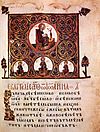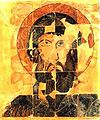- Archbishopric of Ohrid
-
For other uses, see Ohrid Archbishopric (disambiguation).
The Archbishopric of Ochrid was an autonomous Orthodox Church[1][2][3][4] under the tutelage of the Ecumenical Patriarch of Constantinople between 1019 and 1767. It was established following the Byzantine conquest of Bulgaria in 1018 by lowering the rank of the autocephalous Bulgarian Patriarchate due to its subjugation to Constantinople.
Contents
History
Circumstances leading to establishment
In 972, Byzantine Emperor John I Tzimisces conquered and burned down Preslav capturing Bulgarian Tsar Boris II. The Patriarch Damyan managed to escape, initially to Sredetz in western Bulgaria. In the coming years, the residence of the Bulgarian patriarchs remained closely connected to the developments in the war between the next Bulgarian monarchist dynasty, the Comitopuli, and the Byzantine Empire. Thus, the next Patriarch German resided consecutively in Moglen and Voden - (in present-day Greece), and Prespa (in present-day Republic of Macedonia). Around 990, the last patriarch, Philip, moved to Ohrid (in present-day Republic of Macedonia), which also became the permanent seat of the Patriarchate.
 Mantle presented to the Archbishopric of Ohrid from the Byzantine Emperor, Andronikos II Palaiologos, with an inscription, saying that the Archbishop was the spiritual shepherd of the Bulgarians - Bulgarian National Historical Museum.
Mantle presented to the Archbishopric of Ohrid from the Byzantine Emperor, Andronikos II Palaiologos, with an inscription, saying that the Archbishop was the spiritual shepherd of the Bulgarians - Bulgarian National Historical Museum.
History
The Archbishopric of Ochrid was a Byzantine resurrection of the Archbishopric of Justiniana Prima. After 1018 it was the church of the Byzantine Slavs; Bulgarians and Serbs.[5] The Archibishopric was seated in Ohrid in the Byzantine theme of Bulgaria and was established in 1019 by lowering of the rank of the previously autocephalous Bulgarian Patriarchate and its subjugation to the jurisdiction of the Patriarchate of Constantinople. Although the first appointed archbishop (John of Debar) was a Bulgarian, his successors, as well as the whole higher clergy, were invariably Greeks, the most famous of them being Saint Theophylact of Bulgaria (1078–1107).[5]
After the forming of the Latin Empire in 1204, and the poor authority of the Orthodox church in the Balkans (the Crusaders set up their own Patriarchs, after the Greek clergy refused to recognize papal authority[6]), the Empire of Nicaea was established as a Byzantine successor. The Greek Patriarchs held the titles in exile. In the 13th and the first half of the 14th century, the Archbishopric was contested by the Byzantine Empire, the Latin Empire, Second Bulgarian Empire and Serbia. With the forming of the Serbian Kingdom, the whole Archbishopric of Ochrid was united under the Serbian Patriarch. Only in 1368, the Lord of Serres, Jovan Uglješa, de jure re-established the Archbishopric for the independence of his realm. In 1371 the Serbian Empire slowly dissolved, and the Ecumenical Patriarchate once again gained jurisdiction of the southern eparchies. In 1376 however the Archbishopric became part of the Serbian Patriarch, during the rule of Lazar of Serbia.[5]
When the last Serbian Patriarch died in 1463, there were no technical options to elect a new one, so the Ohrid Archbishopric had laid its claim over many of the Serbian Patriarchate's eparchies on the basis of its old 1019 territorial rights, predating the 1219 autocephaly. By the 1520s, the Archbishopric of Ohrid had managed to put practically the entire Serbian Church under its jurisdiction, however by intervention of Mehmed-paša Sokolović in 1557, the latter was renewed and reorganized.
Abolition
The autocephaly of the Ohrid Archbishopric remained respected during the periods of Byzantine, Bulgarian, Serbian and Ottoman rule and the church continued to exist until its abolition in 1767, when it was abolished by the Sultan's decree, at the urging of the Greek church in Istanbul, and was placed under the jurisdiction of the Patriarch of Constantinople.[7]
Language
The Greek language quite early replaced Old Church Slavonic as the official language of the Archbishopric. All documents and even hagiographies of Bulgarian saints, for example the hagiography of Saint Clement of Ohrid, were written in Greek. Despite this, the Slavonic liturgy was preserved on the lower levels of the Church for several centuries.
Administration
The Archbishopric was under the Ecumenical Patriarch of Constantinople.
The following bishoprics (diocese) are mentioned in 1019:
- Bishopric of Ochrid
- Bishopric of Kostur
- Bishopric of Strumica
- Bishopric of Pelagonia,[8] seat at Bitola
- Bishopric of Velbazhd
- Bishopric of Ras,[9] seat at Stari Ras, formed by 878 (as of 1219 part of Serbian Orthodox Church/SOC ).
- Bishopric of Prizren, formed in 10th century (as of 1219 part of SOC)
- Bishopric of Niš, formed by 343 (as of 1219 part of SOC)
- Bishopric of Braničevo, formed by 878 (as of 1219 part of SOC)
- Bishopric of Vidin,
- Bishopric of Sredets,
- Bishopric of Servia, formed in 5th century (as of 1882 part of Ecumenical Patriarchate)
See also
- List of archbishops of the Archbishopric of Ohrid
- Bulgarian Orthodox Church
- Serbian Orthodox Church
- Macedonian Orthodox Church
References and notes
- ^ The Byzantine author Georghis Acropolita calls Demetrius Chomatianus the Archbishop of the Bulgarians. 13th c. Georgii Acropolitae Opera, rec. A. Heisenberg, I-II, Lipsiae 1903; ГИБИ, VIII, p. 158; the original is in Greek [1]
- ^ The Byzantine writer Theodore Scutariot calls Ohrid the Archbishopric of Bulgaria. Bibliotheca Graeca medii aevi, ed. Constant. Sathas. vol. VII, Parisiis, 1894, pp. 5427-54610 - Cf. ГИБИ, VШ, pp. 299-300. 13th c.[2]
- ^ The Byzantine Emperor, Andronicus II Paleologus, presented the Archbishop of Ohrid with a mantle with an inscription saying that the Archbishop was the spiritual head of the Bulgarian population. (Yordan Ivanov, The Bulgarians in Macedonia), pp. 149-150; the original is in Greek.[3]
- ^ The Synodicon of Tsar Boril states that the Archbishops of Ohrid are subordinated to the Turnovo Patriarchate. 14th c. (М. G. Popruzhenko, Synodicon of Tsar Boril, Bulgarian Antiquity), vol. VIII, Sofia, p. 93; the original is in Old Bulgarian [4]
- ^ a b c http://books.google.com/books?id=UjxpAAAAMAAJ
- ^ http://books.google.com/books?id=sJJWEnXTHdIC
- ^ John Shea (1997). Macedonia and Greece: the struggle to define a new Balkan nation. McFarland. p. 173–. ISBN 978-0-7864-0228-1. http://books.google.com/books?id=InyEqBVhH-EC&pg=PA173. Retrieved 19 October 2011.
- ^ Balcanoslavica: Volumes 6-9: "The letters of the archbishop of Ohrid Theophylact from the end of the 11th century sent to the bishop of Pelagonija, as well as the charter of Basil II, show that Bitola was the seat of the bishopric of Pelagonija"
- ^ The entry of the Slavs into Christendom, p. 208
External links
 "Achrida". Catholic Encyclopedia. New York: Robert Appleton Company. 1913. The history of Achrida (Ohrid) according to the Catholic Encyclopedia (1913).
"Achrida". Catholic Encyclopedia. New York: Robert Appleton Company. 1913. The history of Achrida (Ohrid) according to the Catholic Encyclopedia (1913). "Bulgaria". Catholic Encyclopedia. New York: Robert Appleton Company. 1913. History of Bulgaria and the Bulgarian Orthodox Church according to the Catholic Encyclopedia.
"Bulgaria". Catholic Encyclopedia. New York: Robert Appleton Company. 1913. History of Bulgaria and the Bulgarian Orthodox Church according to the Catholic Encyclopedia.
Categories:- 1019 establishments
- Dioceses established in the 11th century
- Bulgarian Orthodox Church
- Serbian Orthodox Church
- Medieval Ohrid
- Bulgarian Empire
- Christianity in medieval Macedonia
- Eastern Orthodox dioceses in Europe
- 11th-century Eastern Orthodoxy
- Ecumenical Patriarchate of Constantinople
- 1767 disestablishments
Wikimedia Foundation. 2010.









